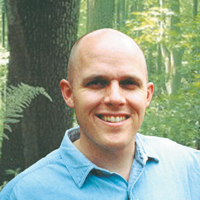|
|
 |
 |
 |
 |
|
ALUMNI
PROFILE
Architect Lance Hosey ’87 was one of two winners of a competition to select a designer for an African-American burial ground memorial at Monticello, Thomas Jefferson’s historic home. The cemetery of at least 20 slaves who worked at Jefferson’s Virginia plantation was discovered last year — the first on the property — and about 120 people entered the open competition to design a memorial. The project especially appealed to Hosey, who works at William McDonough + Partners in Charlottesville, Va., because he already had been researching slave traditions and plantations. For the memorial design, Hosey expanded his research into Monticello, Jefferson and slave burials. Hosey’s design features a circle of tall standing stones with split tops. The stones are meant as traditional burial ground markers — a practice that is thought to have originated in West Africa, where many of Monticello’s slaves were from — as well as a representation of the practice of slaves standing in a circle during clandestine meetings.
The split tops have two meanings. First, Hosey explains, they symbolize the shards of broken pottery with which slaves marked graves as a temporary gravestone and to symbolize the breaking of the body to release the spirit. “They saw death as the first time that they were truly liberated. Breaking pottery was a way of saying, ‘Your chains are broken,’ ” Hosey says. Second, Hosey envisions the broken markers “to suggest frozen land, like in ploughing, because slaves worked the plantation there,” he says. “What I’m trying to do is reinterpret these existing traditions in a more abstract way.” Hosey researched and completed the design on his own time. He received a small honorarium for the design, which was chosen in conjunction with another design for an approach to the memorial. The Thomas Jefferson Foundation is expected to move ahead with the project and complete it in the coming year. Hosey has long been interested in buildings and architecture as a reflection of community. “For me, that’s the most exciting thing about design in general: immersing yourself in the place, its history, and the people you’re doing this for and finding a way to distill all of that,” he says. “I like to think that the form is coming out of something unique to the place.” After graduating from the College, Hosey received a master’s
in architecture from Yale and worked at architectural firms in New
York and Washington, D.C., before moving to Charlottesville in 1999.
He is a member of the American Institute of Architects and has won
awards including a Young Architects Award of Excellence from the
AIA and a JAE Award from the Association of Collegiate Schools of
Architecture for an article on architecture and social demonstration. S.J.B. |
|
||||||||||||||||||||||||||||||||||||||||||

